
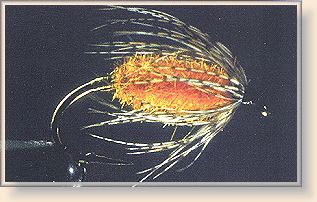 Carrot Nymph By Skip Morris, Port Ludlow, WA, USA
|
|
|
|
|
Tying Instructions: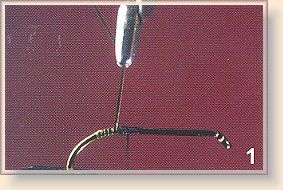 1. Start the thread at the bend. There bind on some fine flat gold tinsel. Most flat Mylar tinsel has a silver side and a gold side. You can bind it on with the silver side up, then fold the tinsel over as you begin wrapping it; or you can simply bind on the tinsel at an angle to the shank, with the gold side up. Either way, you want the gold side showing for the finished tag. Wrap the tag neither overlapping nor spacing the turns. Wrap the tinsel back up to the bend, again in close turns. When it reaches the thread, secure the tinsel's end under tight thread-turns and trim it closely. I like to use hackle pliers in wrapping the tinsel. The tag should reach 3 to 5 turns down the bend.
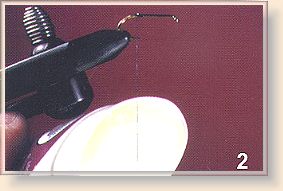 2. Pull down the bobbin until there are about 10 inches (25 cm) of bare thread between it and the hook. Wax the thread.
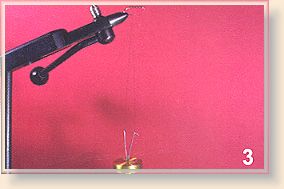 3. Double the thread over a dubbing whirl (shown above) or a dubbing twister. Wrap the end of the thread (the end coming from the bobbin) onto the hook's shank -- the thread should now form a loop, from which hangs the whirl or twister. This loop is often called a "dubbing loop." Wrap the thread toward the bend a bit to lock both ends of the loop in place. The loop should be secured at or just ahead of the bend. Spiral the thread forward to just back from the hook's eye.
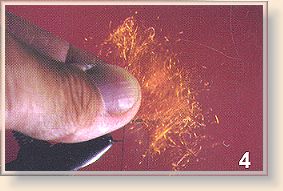 4. Tease a small bunch of bright synthetic dubbing to an elongated triangle (shown is Partridge's SLF, but any bright dubbing is fine.)
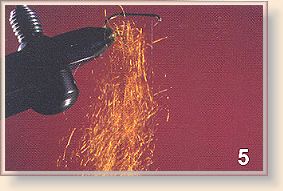 5. Open the thread loop and slip in the triangle of dubbing. The tip of the long dubbing-triangle should be near the hook; the length of the triangle should run along the dubbing loop, not across it. Pinch the sides of the loop together to hold the dubbing lightly in place. Tease the dubbing so that it spreads out along the closed loop.
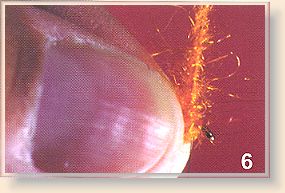 6. Spin the whirl or twister so that the loop of thread and dubbing become tightly twisted into one. If you are using a dubbing whirl, drape the end of the dubbing loop over your finger; then spin the whirl. Make a few wraps of the loop in one spot until the dubbing reaches the shank (the dubbing should reach the shank at the bend; wrap the loop back, if needed to accomplish this.) Wrap the thread-dubbing rope up the shank in close turns to slightly back from the eye. The rope will be shaggy, so it pays to stroke back each turn before adding the next. I often clamp the end of the dubbing loop into hackle pliers for this work.
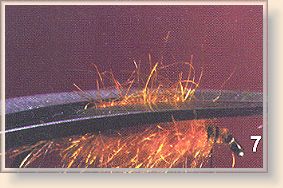 7. Secure the end of the dubing loop with tight thread-turns; trim its end closely. Tease out the body-fibers to fullness with a bodkin. I like to remove the hook from the vise and trim the shaggy body to a taper, or even a cigar shape. With care, this trimming can be done without cutting the thread. But whether or not you cut the thread, a half hitch at the front of the body is good insurance.
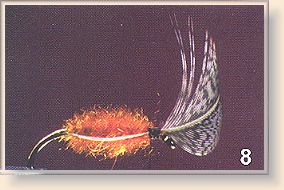 8. Strip the fluffy fibers from the base of a partridge feather and bind it just behind the eye, projecting off the eye. Wrap the thread back in a few tight turns over the stem and shank to the front of the body, and then trim the stem. The fibers remaining at the base of the stripped stem can be as short as the hook's shank to nearly as long as the full length of the hook-- personal preference.
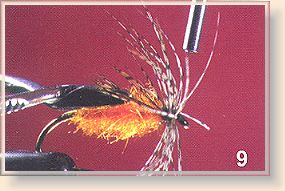 9. Use hackle pliers to wrap the feather back in 2 or 3 close turns to the front of the body. Hold the hackle pliers stationary as you spiral the thread forward through the hackle fibers to the eye. Let the bobbin hang. Trim out the feather's tip.
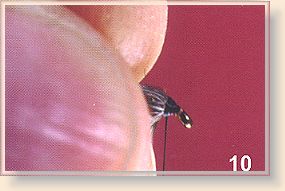 10. Use your fingers formed into a triangle to stroke back all the feather fibers. Holding thus, build a tapered thread head, whip finish and trim the thread, add head cement to the head.
Fishing the Carrot Nymph:
Credits: From Skip Morris's The Art of Tying the Bass Fly Published by Frank Amato Publications. We sincerely thank them for use permission. |